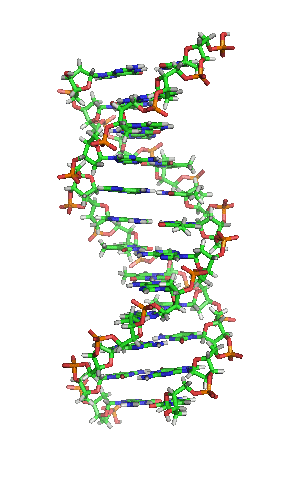Looking for a student learning guide? It’s linked in the main menu for your course. Use the “Courses” menu above.
1. Introduction
In the previous tutorial, we looked at the structure of DNA.

As we’ll see in this tutorial, DNA’s structure lends itself to replication. That’s essential for a molecule that gets passed from one generation to the next during reproduction, and from one cell to the next as an organism grows and develops.
2. Replication means “copying DNA”
Replication involves making two new molecules of “daughter” DNA from one molecule of “parent” DNA.

Here’s an explanation, in verse, of the key idea behind replication.
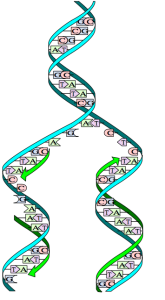

DNA’s structure with its bases complementary
Makes replication easy, but not quite elementary
Since A only bonds with T and C with G
The Double Helix seems to copy naturally,
Or as Crick and Watson said:
“It has not escaped our notice that the specific pairing
We have postulated immediately suggests
A possible copying mechanism
For the genetic material”
James Watson and Francis Crick (along with Maurice Wilkins) were the co-discoverers of the structure of DNA. Their work relied heavily on the work of a fourth scientist, Rosalind Franklin. The quote above is from the conclusion to the paper Watson and Crick wrote in the science journal Nature in 1953, first describing the structure and chemistry of DNA.
3. During DNA Replication, each strand serves as a template for the synthesis of a complementary strand
Here’s a big-picture view of what happens during DNA Replication.
- The strands separate
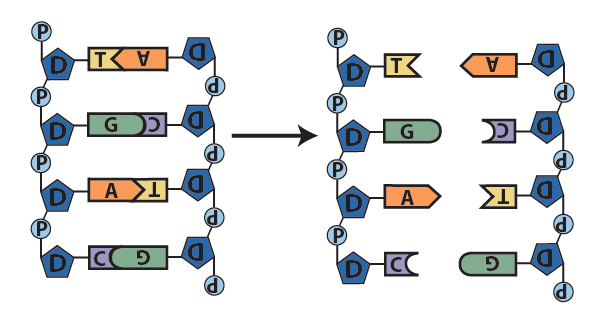
Step 1: the double helix separates into two single strands along part of its length - With bases exposed, each single strand now serves as a template for the synthesis of a new strand. A template is “a molecule … that serves as a pattern for the generation of another macromolecule” (Meriam-Webster, online).
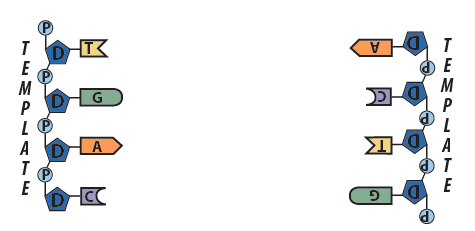
Step 2: Each strand serves as a template for the synthesis of a new strand - Following the base pairing rules, new complementary nucleotides form hydrogen bonds with nucleotides on the template strands.
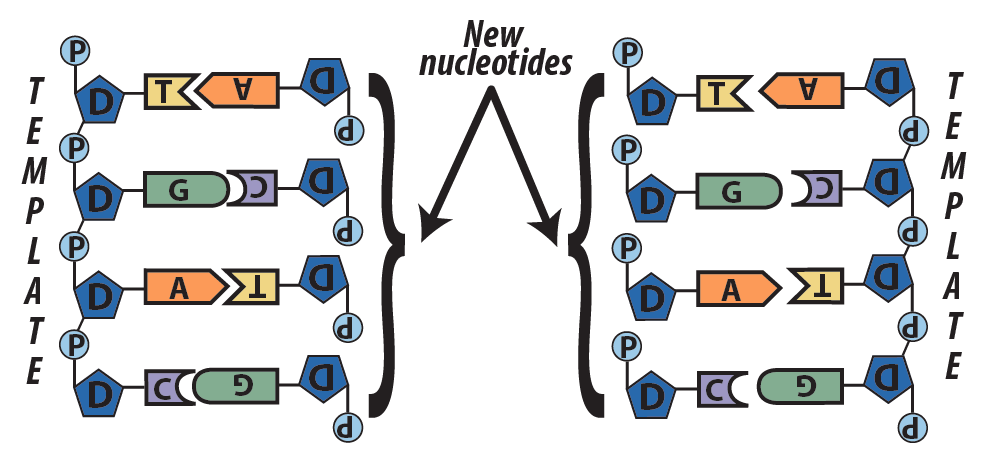
Step 3: new complementary nucleotides bind with the parent strands - Enzymes seal covalent bonds between the sugars and the phosphates of adjacent nucleotides.
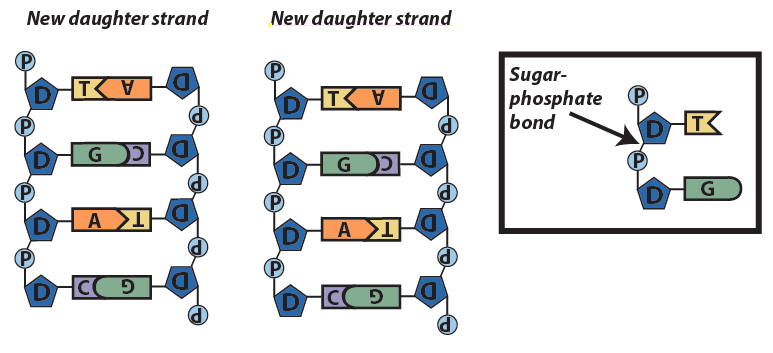
Step 4: Enzymes seal the new strands together with sugar-phosphate bonds.
This model of replication is called semi-conservative: in each new strand, one strand is old, and one strand is new.

Here’s the same explanation in verse:
You first unzip the DNA in one or more places,
Breaking hydrogen bonds to separate the bases.
Each resulting single strand serves as a template,
Allowing enzymes to replicate
New strands with complementary bases that match
And through hydrogen bonds, these bases attach
Each nucleotide now bonds to the next
Through a sugar-phosphate bond they connect
Meselsohn and Stahl proved in ‘58 (read about their experiment)
That this is how the double helix replicates
One strand new, the parent strand preserved,
In other words, the whole thing is semi-conserved.
4. Checking Understanding: DNA Replication (the big picture)
[qwiz random = “true” qrecord_id=”sciencemusicvideosMeister1961-replication-big-picture (AP)”]
[h]DNA replication: The Big Picture
[i]
[q]Copying of DNA is more formally known as [hangman].
[c]cmVwbGljYXRpb24=[Qq]
[q]During replication, each strand acts as a [hangman] for the synthesis of a new strand.
[c]dGVtcGxhdGU=[Qq]
[q]During DNA replication, [hangman] nucleotides on opposite strands of DNA form hydrogen bonds with one another.
[c]Y29tcGxlbWVudGFyeQ==[Qq]
[q]Complementary nucleotides on [hangman] strands of DNA form [hangman] bonds with one another.
[c]b3Bwb3NpdGU=[Qq]
[c]aHlkcm9nZW4=[Qq]
[q]Replication ends as [hangman] create [hangman] bonds between sugars and phosphates on adjacent nucleotides.
[c]ZW56eW1lcw==[Qq]
[c]Y292YWxlbnQ=[Qq]
[q]Replication ends as enzymes create covalent bonds between [hangman] and phosphates on adjacent nucleotides.
[c]c3VnYXJz[Qq]
[q]The result of replication is two daughter DNA molecules, each of which has one [hangman] strand and one old strand.
[c]bmV3[Qq]
[q]Because [hangman] results in daughter strands that are half new and half old, replication is called [hangman]-[hangman].
[c]cmVwbGljYXRpb24=[Qq]
[c]c2VtaQ==[Qq]
[c]Y29uc2VydmF0aXZl[Qq]
[/qwiz]
5. How DNA replication occurs in cells
When you look at a model or diagram of DNA and go about the task of replicating it, you can see the bases, think of the base pairing rules, and manipulate the model (pulling it apart, adding new nucleotides) to create daughter strands from the parent strand. How can cells, which can’t see or think, perform this task?

2. The structure that results from the opening of the helix is called a replication fork.
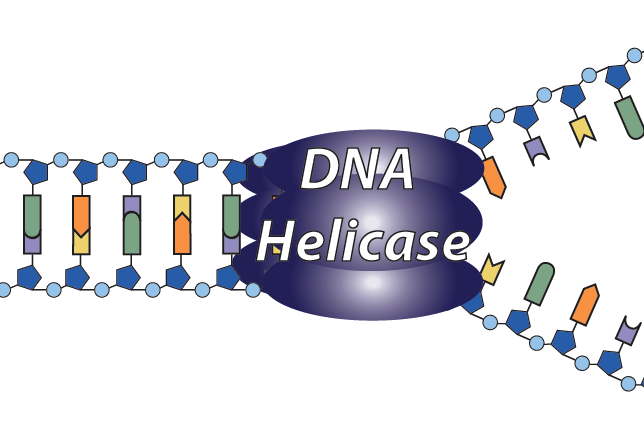
3. Replication forks are always created in pairs, creating a replication bubble (the entire structure below). In the replication bubble below, the original parent DNA is at C, helicase is at B, and newly synthesized DNA is shown in light blue at “D.” The two replication forks are at “E,” and the origin of replication is at “A.” In case you were wondering, we’ll get to the red nucleotides and the direction of the arrows in just a bit.
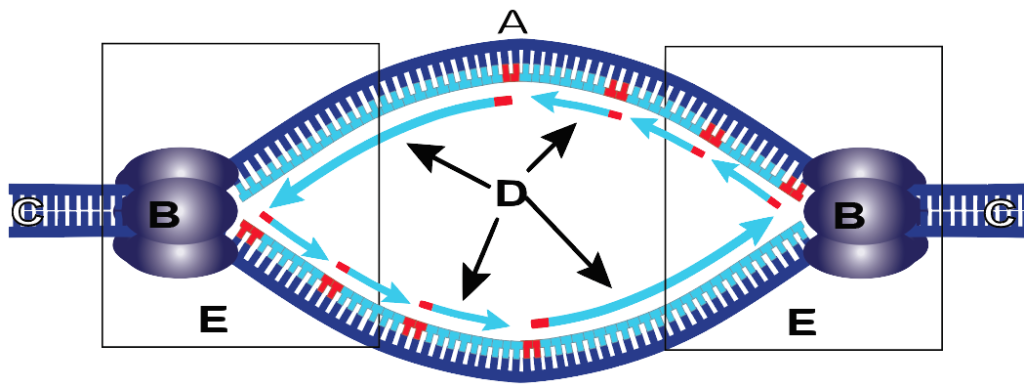
Check out this amazing electron micrograph: What do you think each of the white arrows is pointing to?
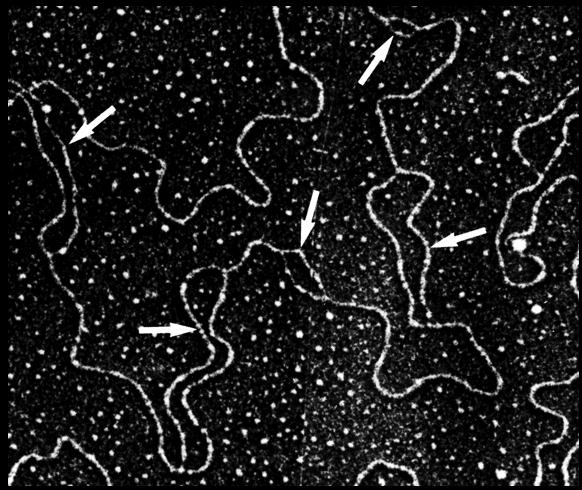
4. To keep the double helix from rewinding, single-strand binding proteins (F) bind with the parent strand just behind helicase.

5. With the nitrogenous bases of the template (parent) strand exposed, the cell can now create complementary DNA on the daughter strand. The enzyme that does this is DNA polymerase III (“G” below). DNA polymerase III rides along the parent strand. As new nucleotides form hydrogen bonds with their complements on the template strand, DNA polymerase III catalyzes a sugar-phosphate bond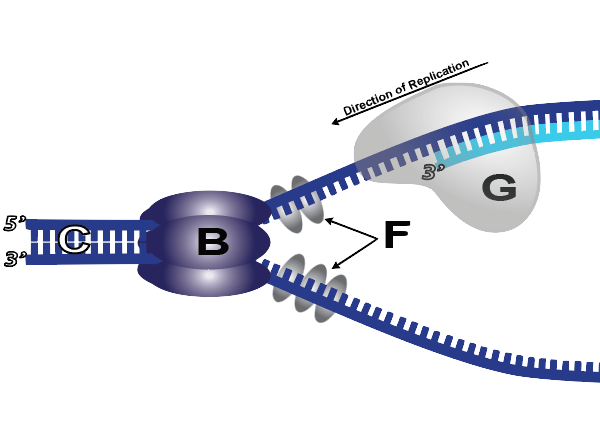 between the growing strand and the new nucleotide at the 3′ end of the growing strand. (See the previous tutorial for a review of 5′ and 3′). Note that DNA polymerase “knows” which nucleotide is the right one based on its fit with the nucleotide on the parent strand. The right nucleotide (A with T, for example) will “feel right,” causing DNA polymerase’s active site to change shape (by induced fit) and catalyze the bond.
between the growing strand and the new nucleotide at the 3′ end of the growing strand. (See the previous tutorial for a review of 5′ and 3′). Note that DNA polymerase “knows” which nucleotide is the right one based on its fit with the nucleotide on the parent strand. The right nucleotide (A with T, for example) will “feel right,” causing DNA polymerase’s active site to change shape (by induced fit) and catalyze the bond.
6. DNA polymerase III can attach new nucleotides to a growing strand, but it can’t add a new nucleotide if there’s nothing to attach to. As a result, DNA polymerase III can’t initiate replication. Instead, another enzyme called primase (I) adds a short RNA primer (H). Once in place, DNA polymerase III can continue the replication process.
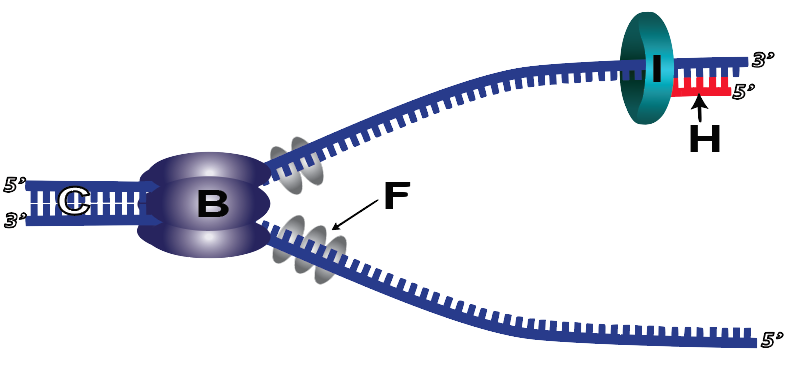
8. Because DNA polymerase III can only add new nucleotides at the 3′ end, a few more complications occur during DNA replication. The first has to do with what’s called the leading and lagging strands.
In the diagram below you see a replication bubble. The two DNA polymerase III enzymes that are following the opening replication forks are synthesizing new complementary DNA strands and attaching new nucleotides at the 3′ end. I’ve marked this new DNA with the letter “J.” This strand is known as the leading strand.
But how can DNA polymerase III synthesize a complementary DNA strand where I’ve put a question mark? That would require DNA polymerase III to add new nucleotides at the 5′ end, which it can’t do.
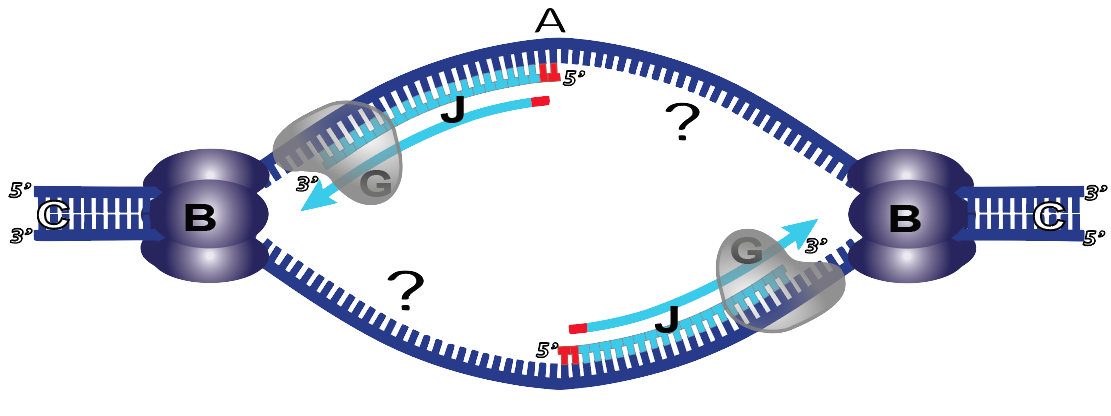
The strand where I’ve put a question mark is known as the lagging strand. It’s where synthesis moves away from the opening replication fork. This is in contrast to J, where DNA synthesis follows the replication fork. The solution for the lagging strand is for DNA synthesis to proceed in fragments, shown below at “K.”
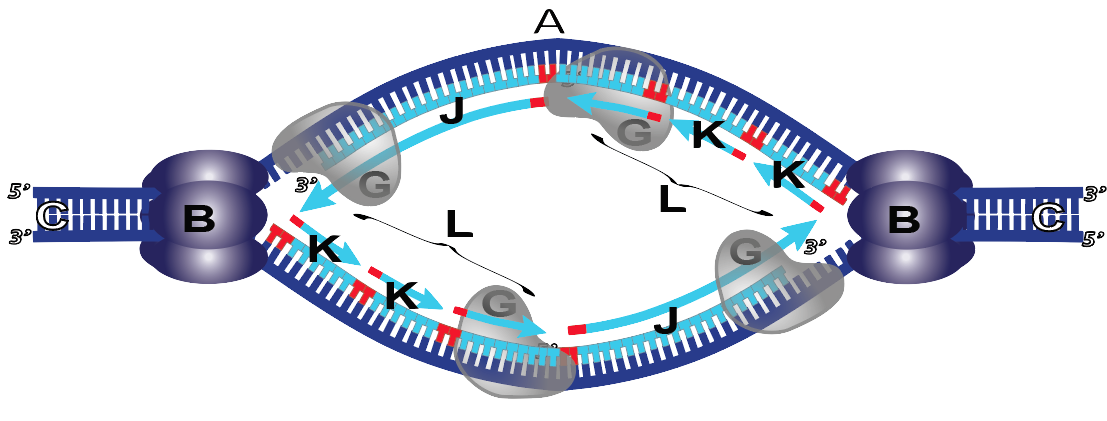
What you can see above is that on the leading strand (J), DNA synthesis is continuous. By contrast, in the lagging strand (L), DNA synthesis is fragmentary. Try to imagine the following: as the replication fork opens, Primase lays down its RNA primer. Then DNA polymerase comes in and lays down a short fragment of new DNA. When it reaches the RNA primer from another fragment, the DNA polymerase stops. Note that in honor of their discoverer, Reiji Okazaki, these fragments are called “Okazaki fragments.”
9. Because of Okazaki fragments and primers, there’s a lot of cleanup required at the end of the process. Cleanup begins as an enzyme called DNA polymerase I (shown at K below) comes and removes the primer, replacing RNA nucleotides with DNA nucleotides.
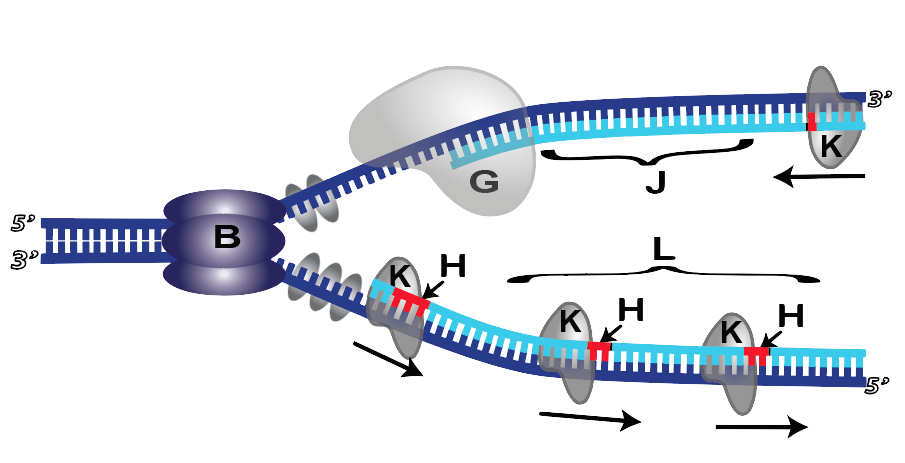
10. But even after the primer is removed, there’s still a gap (because DNA polymerase 1 can only add nucleotides to an existing strand: it can’t connect two strands together). To do this, a final enzyme, DNA ligase (N), comes and closes the gap between fragments.
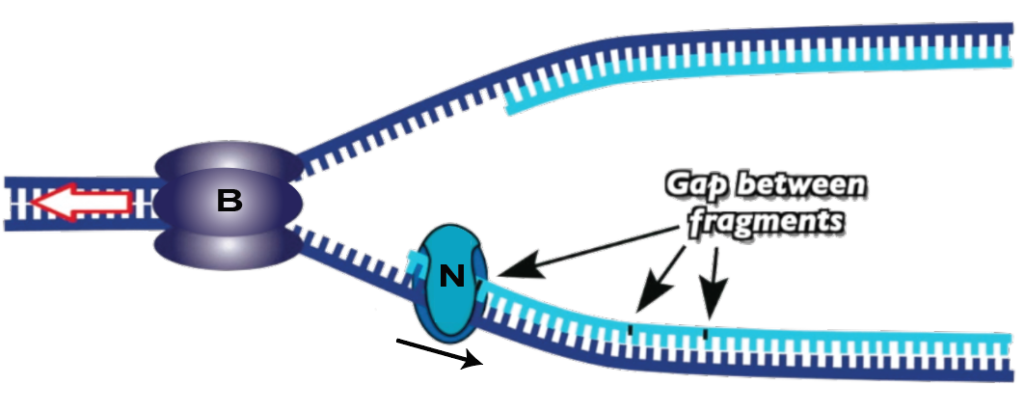
6. And Here’s What It Really Looks Like
The process I described above is a great model for understanding DNA replication. But it’s actually much more complex. Watch this computer animation from the Howard Hughes Medical Institute.
7. Quiz: DNA Replication (with some DNA structure review)
The quiz below uses a combination of diagrams, multiple choice, and fill-in-the-blanks to help you consolidate your knowledge of DNA replication, as well as DNA structure.
[qwiz use_dataset=”DNA Replication (AP)” random = “true” dataset_intro=”false” qrecord_id=”sciencemusicvideosMeister1961-replication-Details (AP-DS)” dataset_intro=”false”]
[h]DNA Replication (and some DNA structure)
[i]
[/qwiz]
8. DNA Replication: Interactive Lyrics
I’m assuming you’ve already watched my DNA Replication music video. If not, please click here.
[qwiz qrecord_id=”sciencemusicvideosMeister1961-DNA Replication Interactive Lyrics”]
[h]Interactive Lyrics: DNA Replication
[i]
- As you read, drag answers from the top into the appropriate spot.
- Reading this way will increase your retention of the song’s content.
Makes replication easy, but not quite elementary
Since A only bonds with T and C with G,
The _____________ seems to copy naturally,
or as Crick and _________ said
[l]complementary
[fx] No. Please try again.
[f*] Good!
[l]double helix
[fx] No. Please try again.
[f*] Excellent!
[l]Watson
[fx] No. Please try again.
[f*] Excellent!
[q labels = “top”]
CHORUS
“It has not escaped our notice
that that the specific _______
we have postulated
immediately suggests
A possible _________ mechanism
for the _________ material.”
[l]copying
[fx] No, that’s not correct. Please try again.
[f*] Excellent!
[l]genetic
[fx] No. Please try again.
[f*] Good!
[l]pairing
[fx] No, that’s not correct. Please try again.
[f*] Good!
[q labels = “top”]
You first unzip the DNA in one or more places,
Breaking ____________________ to separate the bases.
Each resulting single strand serves as a template,
Allowing enzymes to replicate
New strands with complementary bases that match
And through hydrogen bonds these bases attach
Each nucleotide now bonds to the next
Through a ____________________ bond they connect
Meselsohn and Stahl proved in ‘58
That this is how the double helix __________
One strand new, the parent strand preserved,
In other words the whole thing is semi-conserved,
[l]hydrogen bonds
[fx] No. Please try again.
[f*] Great!
[l]replicates
[fx] No, that’s not correct. Please try again.
[f*] Good!
[l]sugar–phosphate
[fx] No. Please try again.
[f*] Correct!
[q labels = “top”]
Now let’s see how replication really goes,
With blind, mindless enzymes controlling the show.
Made more complex by something you can see
Each DNA strand has ________________.
5 prime to 3 is how the enzymes go,
(Just refer to the carbons in ______________)
So when a new strand is synthesized
_____________ get added on the 3 prime side
[l]deoxyribose
[fx] No. Please try again.
[f*] Good!
[l]directionality
[fx] No. Please try again.
[f*] Good!
[l]Nucleotides
[fx] No. Please try again.
[f*] Good!
[q labels = “top”]
The process begins with __________,
Which opens up the helix at a special place
Breaking hydrogen bonds at the origin,
A sequence telling helicase where to begin
A replication fork is now composed,
Where both __________________ have their bases exposed
And to keep the double helix from rewinding,
Single strand proteins come in and start _________.
[l]binding
[fx] No, that’s not correct. Please try again.
[f*] Great!
[l]helicase
[fx] No, that’s not correct. Please try again.
[f*] Great!
[l]parent strands
[fx] No, that’s not correct. Please try again.
[f*] Good!
[q labels = “top”]
Note two forks always form when DNA doubles,
The whole thing’s called a ____________ bubble
Now it’s primase’s turn, the next enzyme
To come to the origin at this time
_________ lays down a primer of RNA,
Complementary to the template DNA.
Setting the stage for the star of our show
DNA ______________, now set to go.
[l]Primase
[fx] No. Please try again.
[f*] Excellent!
[l]polymerase
[fx] No. Please try again.
[f*] Great!
[l]replication
[fx] No, that’s not correct. Please try again.
[f*] Good!
[q labels = “top”]
DNA polymerase’s job is to add
_________________________ to a growing strand.
But polymerase needs a growing strand in place,
Which is why ____________ is the job of primase.
What happens now is simple, it’s a replication race,
As polymerase follows helicase,
As the fork opens up, replication proceeds,
With ______________ added at incredible speed.
[l]Deoxyribonucleotides
[fx] No. Please try again.
[f*] Good!
[l]initiation
[fx] No. Please try again.
[f*] Excellent!
[l]nucleotides
[fx] No. Please try again.
[f*] Excellent!
[q labels = “top”]
What we’ve said applies to the leading strand
Where replication’s smooth, continuous and grand,
But on the _________ strand, fork opens 3 to 5:
a direction where polymerase can’t polymerize
So instead of following helicase,
______________ moves away from the forking place
So replication’s lagging, and ______________
As discovered in ‘66 by Okazaki
[l]fragmentary
[fx] No, that’s not correct. Please try again.
[f*] Great!
[l]second
[fx] No. Please try again.
[f*] Excellent!
[l]Polymerase
[fx] No. Please try again.
[f*] Correct!
[q labels = “top”]
So the lagging DNA’s filled with __________ fragments,
And RNA primers, and to clean up this mess,
________________ removes the primer,
Puts deoxyribonucleotides in what could be finer?
And now the fragments need to be connected,
So the new DNA can be perfected,
Ligase carries out this function with pride,
Sealing sugar-phosphate bonds between _____________.
[l]nucleotides
[fx] No. Please try again.
[f*] Good!
[l]Okazaki
[fx] No. Please try again.
[f*] Great!
[l]Polymerase 1
[fx] No. Please try again.
[f*] Good!
[/qwiz]
9. DNA Replication Quiz 2
[qwiz random = “true” qrecord_id=”sciencemusicvideosMeister1961-DNA Replication Vocabulary”]
[h]DNA Replication Vocabulary Quiz
[i]
[q]The bases in DNA are [hangman] to one another.
[c]Y29tcGxlbWVudGFyeQ==
Cg==[Qq]
[q]In the DNA base pairing rules, [hangman] always bonds with thymine.
[c]YWRlbmluZQ==
Cg==[Qq]
[q]In the DNA base pairing rules, [hangman] always bonds with cytosine.
[c]Z3VhbmluZQ==
Cg==[Qq]
[q]In the DNA base pairing rules, guanine always bonds with [hangman].
[c]Y3l0b3NpbmU=
Cg==[Qq]
[q]During DNA replication, [hangman] bonds between complementary bases need to be broken.
[c]aHlkcm9nZW4=
Cg==[Qq]
[q]During DNA replication, hydrogen bonds between [hangman] bases need to be broken.
[c]Y29tcGxlbWVudGFyeQ==
Cg==Cg==[Qq]
[q]During replication, each strand serves as a [hangman] for the synthesis of a second strand.
[c]dGVtcGxhdGU=
Cg==[Qq]
[q]Adjacent nucleotides on the same strand are connected to one another through [hangman]-[hangman] bonds.
[c]c3VnYXI=[Qq]
[c]cGhvc3BoYXRl
Cg==[Qq]
[q]The Meselson-Stahl experiment proved that DNA replication was [hangman]-[hangman].
[c]c2VtaQ==[Qq]
[c]Y29uc2VydmF0aXZl
Cg==[Qq]
[q]During DNA replication, the key enzymes always move in a [hangman] prime to [hangman] prime direction
[c]Zml2ZQ==[Qq]
[c]dGhyZWU=
Cg==[Qq]
[q]When nucleotides are added to a growing DNA strand, they’re always added on the [hangman] prime side.
[c]dGhyZWU=
Cg==[Qq]
[q]The enzyme that opens up the double helix is [hangman].
[c]aGVsaWNhc2U=
Cg==[Qq]
[q]Helicase is the enzyme that breaks [hangman] bonds between complementary bases.
[c]aHlkcm9nZW4=
Cg==[Qq]
[q]Helicase first opens up the double helix at a sequence of bases called the origin of [hangman].
[c]cmVwbGljYXRpb24=
Cg==[Qq]
[q]As helicase separates the strands in DNA, a [hangman] [hangman] forms.
[c]cmVwbGljYXRpb24=[Qq]
[c]Zm9yaw==
Cg==[Qq]
[q]The structure formed by two replication forks is called a replication [hangman].
[c]YnViYmxl
Cg==[Qq]
[q]During replication, [hangman]-[hangman]-[hangman]-[hangman] prevent the double helix from rewinding.
[c]c2luZ2xl[Qq]
[c]c3RyYW5k[Qq]
[c]YmluZGluZw==[Qq]
[c]cHJvdGVpbnM=
Cg==[Qq]
[q]After helicase opens up the double helix, [hangman] lays down a primer of RNA.
[c]cHJpbWFzZQ==
Cg==[Qq]
[q]After helicase opens up the double helix, primase lays down a primer of [hangman].
[c]Uk5B
Cg==[Qq]
[q][hangman] of replication is the job of primase.
[c]SW5pdGlhdGlvbg==
Cg==[Qq]
[q]On the [hangman] strand, the fork opens up in a 3′ to 5′ direction.
[c]bGFnZ2luZw==
Cg==[Qq]
[q]The job of [hangman] 1 is to remove the RNA primer.
[c]cG9seW1lcmFzZQ==
Cg==[Qq]
[q]The enzyme whose job it is to connect the [hangman] created during replication is ligase.
[c]ZnJhZ21lbnRz
Cg==[Qq]
[q]The enzyme whose job it is to connect the fragments created during replication is [hangman].
[c]bGlnYXNl
Cg==[Qq]
[q]Ligase creates [hangman]-[hangman] bonds between nucleotides.
[c]c3VnYXI=[Qq]
[c]cGhvc3BoYXRl[Qq]
[x][restart]
[/qwiz]
Next steps
- Transcription and Translation (the next series of molecular genetics tutorials)
- DNA Structure and Replication Main Menu
- DNA Replication Rap (a salsa-themed music video)

